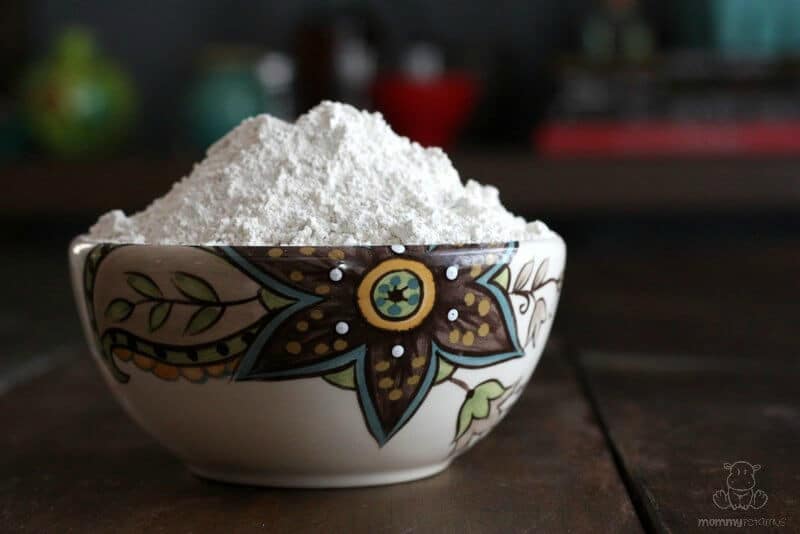
So, the other day I was talking to a friend about this homemade deodorant for sensitive skin, and she wondered aloud if she really needed to buy “a whole bag of this diatomaceous earth stuff just to make deodorant.”
And I was like, WAIT, YOU DON’T HAVE SOME ALREADY??
Clearly I have failed as a friend, because you guys, this stuff is awesome. It helps support detoxification, rid your pets and home of critters, and keep your garden healthy, you can even use it in your beauty routine. I’ll tell you how in this post, but first might be wondering…
What is food grade diatomaceous earth, anyway?
Good question! Diatomaceous earth (DE) is a fine powder made from diatoms, a type of fossilized phytoplankton. It looks like Rice Chex under a microscope, only in cylindrical form. Weird, right?
DE is unique in composition – it’s about 80-90% pure silica, with other minerals making up the remaining 10-20%.
It’s exceptional in another way, too – it carries a strong negative ionic charge. (1) This study suggests it helps to reduce internal parasites in chickens, and many experts believe this is due to its negative charge and cylindrical shape. The thinking behind this is that positively charged bacteria and parasites (plus some viruses) may be attracted to it like magnets are attracted to one another. Because of its shape, the pathogens get trapped in the center and carried out of the body.
There are two main forms of diatomaceous earth:
- Food grade diatomaceous earth (amorphous silica) – In order to qualify as food grade, the silica in DE needs to be 99% amorphous silica with less than 1% crystalline silica.
- Filter grade/ pool grade diatomaceous earth (crystalline silica) – Manufacturers expose amorphous silica to extremely high temperatures (over 1832 degrees Fahrenheit), which changes the structure of the silica into a crystalline form. Filter grade silica is valuable for many industrial purposes, such as removing heavy metals from water, but is not considered safe to be inhaled or ingested. (2) (3) Another DE in this category is anything formulated with additional ingredients for pest control.
Is food grade diatomaceous earth safe for human consumption?
Yes. Diatomaceous earth was consumed by humans in a study we’ll discuss below, where it was found to have possible benefits for lipid metabolism. Also, it is Generally Regarded as Safe (G.R.A.S.) by the FDA, and is used to filter wine/beer.
How is diatomaceous earth different from bentonite clay?
If you’ve been around for awhile you know that I use clay for everything from washing my hair to making soap. Clay is incredibly versatile and can sometimes be used interchangeably with diatomaceous earth, but the two powders are different. Bentonite clay typically comes from volcanic ash deposits, while diatomaceous earth is a powder made from fossilized phytoplankton.
Because it is made up of tiny, hard phytoplankton, DE works well as a gentle abrasive. It attaches to the protective waxy outer coating/exoskeleton of pests and dehydrates or scrapes it away, causing them to dry out and die. Likewise, it can be used to mechanically remove stains from teeth or slough off dry, dead skin. I have found it to be slightly more effective in controlling odor in my homemade deodorant than clay, though I have used clay with success.
Bentonite and other clays such as rhassoul work primarily by absorbing (drawing within the clay) and adsorbing (drawing to the outside of the clay) impurities, which makes it ideal for gentle applications. For example, it also helps to remove stains and whiten teeth, but it does so by drawing stains out rather than removing them physically. So as you can see, there’s a lot of crossover in terms of benefits but they are not quite the same.
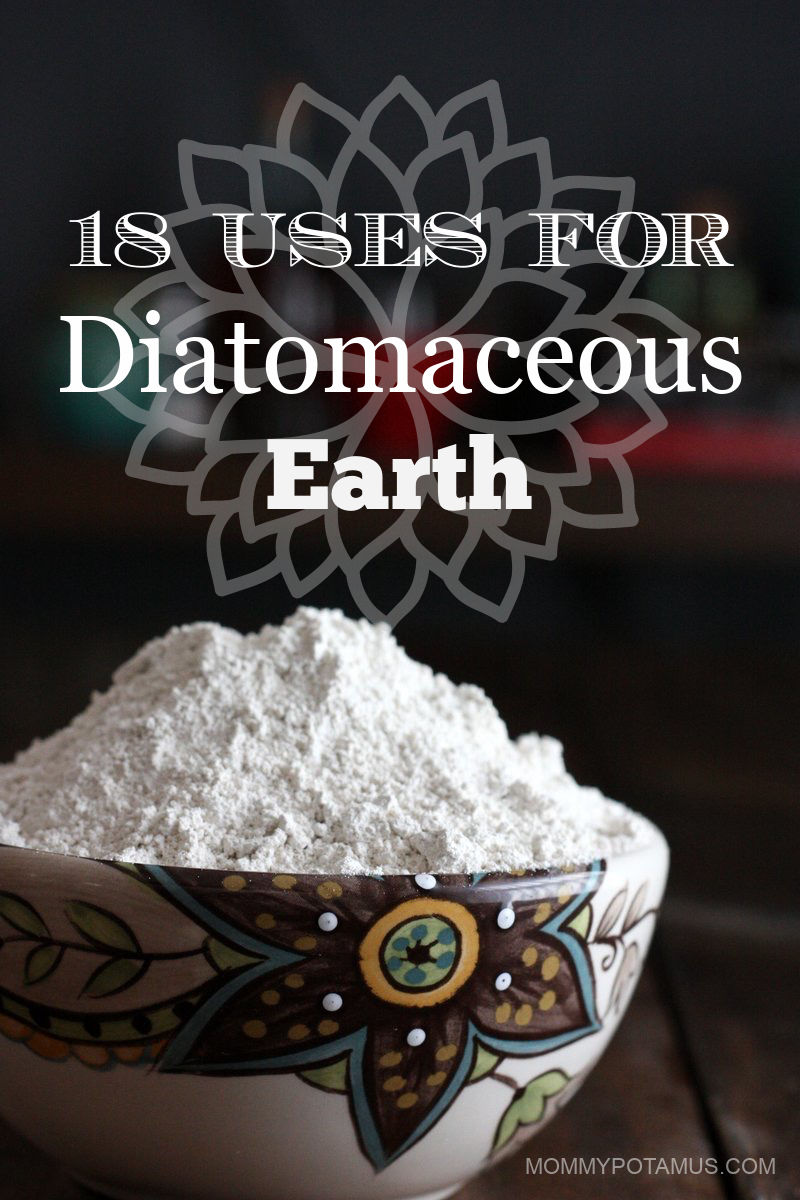
18 Ways To Use Diatomaceous Earth for Health, Home & Garden
There are so many ways to use DE in the home, for skin care, with pets and more. Here are a few of them, with links to recipes to get you started:
1. Detoxification Support
Dr. Natasha Campbell-McBride M.D., author of Gut & Psychology Syndrome, advocates the internal use of food grade diatomaceous earth for general detoxification support. However, she says that it should not be taken by people who have severe conditions such as Crohn’s disease or Ulcerative Colitis. (4)
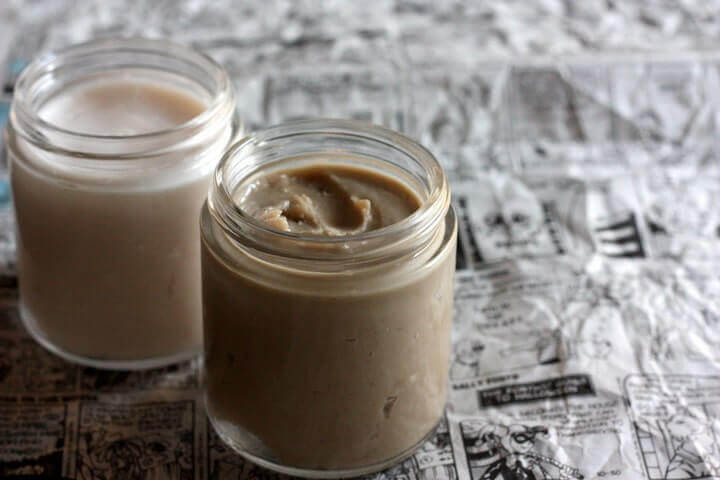
2. Deodorant
Though our primary detox pathways are through the liver, kidneys, colon and lymph system, our skin and lungs also assist with detoxification. We don’t want to block our body’s ability to sweat with antiperspirants, but we can keep things fresh in the underarm area by neutralizing odor.
Diatomaceous earth is great for this. And because it tends not to be quite as alkaline as baking soda – which is commonly used in homemade deodorants – it is often preferred by individuals who have experienced rashes or irritation after application. Here’s my deodorant recipe.
3. Toothpaste
Sprinkle a little DE over your tooth soap, toothpaste, or homemade tooth powder for extra deep cleaning power. Because it is gently abrasive only a little is needed to effectively remove stains, and it should only be used every once in awhile.
4. Facial Scrub & Mask
Because it’s very fine, diatomaceous earth makes a gentle facial exfoliant and mask. In addition to its main component, silica, DE also contains calcium, magnesium, zinc, copper, selenium, phosphorous and other trace minerals. Since minerals can be absorbed through the skin, this is a wonderful way to complement a mineral-rich diet.
To use: Mix about 1 tablespoon of diatomaceous earth with water, milk, aloe vera juice or diluted honey to make a thick paste. Using your fingertips, lightly massage the paste onto your face using small, circular motions. Allow the paste to set for 1-2 minutes, then gently remove with a warm washcloth using small, circular motions. This last stage is when most of the exfoliation occurs. Follow with toner (if you use it) and a moisturizer like tallow balm or my hydrating skin repair serum recipe.
Special note: Avoid using this scrub near the eyes or on chapped skin.
5. Supports Healthy Cholesterol Levels
This study suggests that diatomaceous earth may be beneficial for lipid metabolism and cholesterol levels. Who knew?
6. Food Storage
DE is added to grains and legumes such as wheat, maize, beans and barley to prevent spoilage. It keeps food dry, prevents mold, and protects against pests like weevils and beetles.
7. Bed Bugs
The FDA approved diatomaceous earth for use against bed bugs, fleas. Here is a tutorial for applying it throughout the home.
A couple of notes: First, the product in this tutorial contains 2% synthetic ingredients. Though it is certainly better than some pesticides used to eliminate bed bugs, I personally would go with 100% DE before trying it.
Second, there are a lot of cautions against breathing in diatomaceous earth. While I would definitely use a mask to apply using the method in the video, I found this statement over on I Breathe, I’m Hungry helpful:
I received an email from Larry Smith, the President of Earthworks, who wanted to clear up the misconception about any dangers of inhaling food grade diatomaceous earth – here’s what he wrote: ‘This is a misunderstanding about food grade DE. There are 2 kinds of DE—food grade and filter grade (used in swimming pool and other filters) Only the filter grade is dangerous to breathe. The “dangerous” part of DE is the amount of crystalline silica that is in it. Filter grade is 65% crystalline silica while food grade is less than 1/10 of 1%! The world health org. has said that diatomaceous earth is safe to breathe as long as the crystalline content is under 2%. Food grade is 20X lower than even that level!!’
So no need to be concerned about any danger associated with using DE for pets, bedding, consumption or anything else – as long as it’s FOOD GRADE! “
8. Garden Pest Control
Diatomaceous earth can be used to kill slugs, beetles, and other unwanted pests in the garden. Here’s how to use it. However, please keep in mind that it should be used wisely, because most bugs are beneficial and we want to preserve their habitats.
9. Flea Infestations
I can’t help but giggle a little when watching this video on how to treat pets for fleas using diatomaceous earth, but it has some very good info . . .
Something to keep in mind is that it’s also important to treat any carpet pets come into contact with, plus areas they like to nap in, etc. Here’s how to treat your carpet and home for fleas using DE.
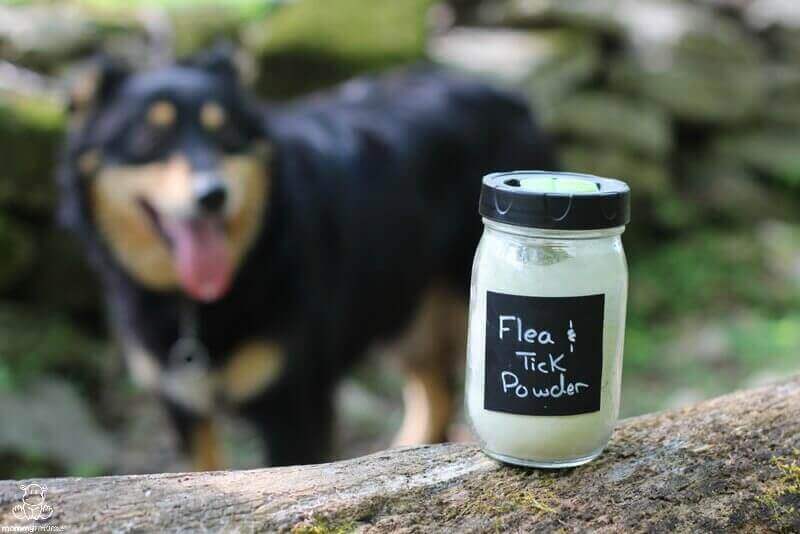
10. DIY Natural Flea Powder
Speaking of fleas, guess what the main ingredient is in this natural flea powder for dogs and cats? Yep, DE.
If you’d rather make it instead of buy it, here’s my natural tick and flea powder recipe for dogs.
11. Cockroach, Spider, Tick and Earwig Control
Diatomaceous earth is approved for use against all of these home pests. Experts recommend using a hand duster to puff it into cracks and crevices where bugs are likely to hang out.
12. Fridge Deodorizer
Place a small container/box of diatomaceous earth in the fridge or freezer to neutralize odors. Replace it every 1-2 weeks.
13. Garbage Can Deodorizer
Sprinkle in the bottom of the can to help neutralize odors.
14. Stain Remover
Because of its highly absorbent nature, diatomaceous can be sprinkled on oil-stained clothes to help soak up the oil. I like to pair it with this homemade stain remover for stubborn stains.
15. Spill Clean Up
Just like with clothes, diatomaceous earth can help soak up oil stains on carpets, driveways and garage floors.
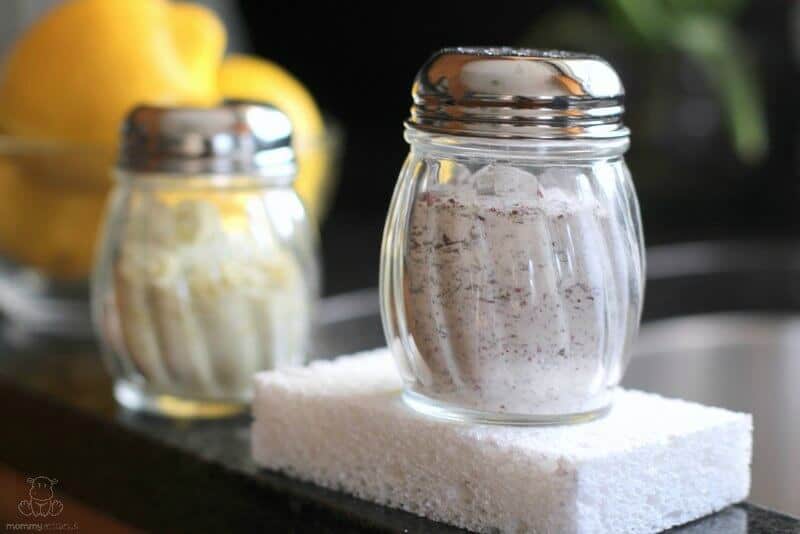
16. Scouring Powder
It can can be used to make homemade scouring powder for hard surfaces such as sinks, bathtubs and countertops. Something to keep in mind that DE turns brown when wet so it will look like you’re cleaning with dirt. It works beautifully, though, and it’s easy to see where to rinse!
17. Chicken Feed
As mentioned earlier, this study suggests it helps to reduce parasites in chickens. The FDA has approved it for use as an anti-caking agent in commercial livestock feed at a rate of 2% overall weight, so that’s the guideline that most people use. (5) In case you’re wondering what that looks like practically, for 25 pounds of feed you would add 1/2 pound of diatomaceous earth to get the 2% ratio.
18. Lice
Although not my first choice since it can dry out the scalp and hair, too, DE is thought to help with lice by drying out the nits and eggs. Read more about natural remedies for lice here.
Possible Additional Health Benefits of Diatomaceous Earth
Although the silica content in DE is high, opinions vary on bioavailability. Some say that it’s not well-absorbed, while others say that a meaningful amount is bioavailable to the body when taken internally. If the body is able to use absorb and use the silica in DE, here are some additional possible benefits.
Collagen Production
Silica, which is a type of silicon, is essential for collagen formation. In one study, animals that were supplemented with a small amount of highly bioavailable silicon had a 12% higher collagen concentration than animals who weren’t. (6)
Hair Thickness & Strength
In this study, supplementing women with a form of silicon (choline-stabilized orthosilicic acid) increased the strength and thickness of their hair.
Strong Nails
Along with gelatin and biotin, silica is essential for building strong, healthy nails.
Strong Teeth and Bones
Silica is essential for the formation of the hard outer enamel that protects our teeth, and according to this PubMed article it is likewise beneficial for overall bone formation and health.
How I Take Food Grade DE Internally
Most people say food grade diatomaceous earth should be taken on an empty stomach. What this means is somewhat vague, but from what I can tell best practices are to take it either:
1. First thing in the morning, then wait 30 minutes to eat
-Or-
2. Three hours after eating
When I started taking diatomaceous earth, I began with one teaspoon in a tall glass of purified drinking water (8 oz.) and worked my way up to one tablespoon over the course of a week. I schedule breaks from DE (and all other supplements) to give my body a break. In the case of DE, I prefer to use it for about a month continuously, then I take 1-2 teaspoons once or twice a week after that.
Where To Buy Diatomaceous Earth
When I first learned about food grade DE, I immediately called my local Hope Depot and Lowe’s to find out if they had it. It led to a couple of pretty funny conversations with the garden department, but no actual DE.
These days I buy mine online. I like this brand because it’s listed with the Organic Materials Review Institute (OMRI). The OMRI seal ensures that a product is suitable for organic farmers to use, so it’s not necessary for gardeners and people who want to use it internally, externally or around the house. However, I look for the OMRI mention because those sellers have gone through the process of having their DE independently verified for quality.
This one is OMRI listed, too, and comes with a dusting applicator.
Do you have a favorite use for diatomaceous earth? Please share it in the comments!
Sources:
1. ClearOff Minerals. What Is Diatomaceous Earth? Retrieved from https://ift.tt/2XqtiOO
2. Danil de Namor, AF et. al. (2012) Turning the volume down on heavy metals using tuned diatomite. A review of diatomite and modified diatomite for the extraction of heavy metals from water.. Retrieved from https://ift.tt/2JqeVjM
3. Blaettler, Karen (2018) Differences Between Fuller’s Earth & Diatomaceous Earth. Retrieved from https://ift.tt/2Xw8upd
4. GAPS Diet: Natural Digestive Healing. Detoxification. Retrieved from https://ift.tt/2JsXmQ7
5. FDA. Code of Federal Regulations Title 21. Retrieved from https://ift.tt/2XvPF5E
6. Source: Jarrow Formula’s application to FDA for their silicon supplement, BioSil
Disclaimer: These statements have not been evaluated by the FDA and are not meant to diagnose, treat, or cure any disease. Please see my full disclaimer here.
This article was medically reviewed by Dr. Mariza Snyder, a functional practitioner. As always, this is not personal medical advice and we recommend that you talk with your doctor.
Continue reading 18 Uses for Food Grade Diatomaceous Earth...
from Mommypotamus https://ift.tt/2JxgaOl
 Reviewed by Unbelievable Tamil Facts
on
July 06, 2019
Rating:
Reviewed by Unbelievable Tamil Facts
on
July 06, 2019
Rating:



No comments: